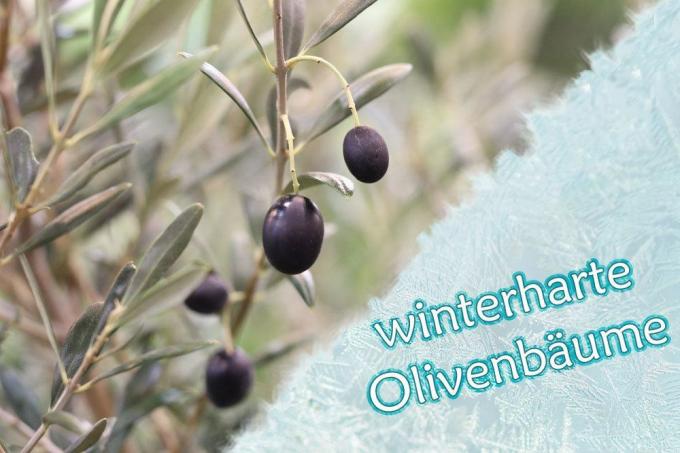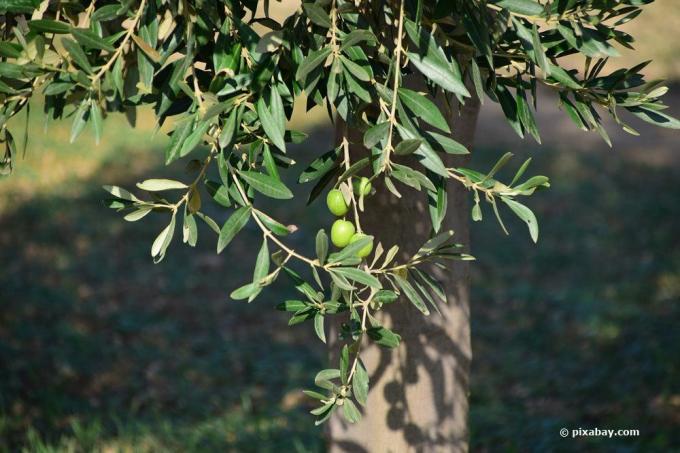
table of contents
- Hardy olive trees?
- Suitable winter hardiness zones
- Likelihood of confusion
- Cold protection
- Hardy olive tree species
- Real olive tree
- More olive trees
- Hardest olive trees
- Conditionally hardy / hardy
- Hardy young plants
- Kind unknown
Olive trees are becoming increasingly popular in Germany because they conjure up a Mediterranean flair on balconies and in the garden. They are relatively expensive to buy, so it is annoying when they face the end of the gardening season and freeze to death in winter because they have been left outside. Hardy olive trees would be the solution to the problem. But do they exist? The plant expert answers the question.
Hardy olive trees?
Yes and no is the answer to the question of whether there are hardy olive trees. There are varieties available that are very sensitive to frost. These usually come from tropical areas with summer temperatures all year round, such as in the Dominican Republic or in large parts of Tunisia. The olive trees from there would not be able to cope with the central European climate in winter.
But there are olive trees that have limited frost tolerance. These come mainly from the Mediterranean region, mainly from Spain and the Pyrenees. There the temperatures fluctuate in some regions down to lower ranges. Olea europaea species derived from these acclimate themselves better in Central Europe and tolerate sub-zero temperatures - but only with insulating protection against the cold.
Suitable winter hardiness zones
In mild regions such as in wine-growing areas, for example, hardy olive trees withstand the cold season in the garden or on the balcony without any problems. Experience shows that temperatures down to -10 ° C with protection against the cold do not bother them in other regions either. This means that "hardy" species are suitable for the hardiness zones between 8 and 13 if they are provided with protection against the cold. Few specimens, as special breeds, are also tolerant of cold down to -20 ° C or more. This corresponds to the maximum winter hardiness zone 6b.
Note: The winter hardiness zone is an international division, which is based on the lowest annual temperature averages. Winter hardiness zones start at 1 with down to -51.1 ° C and end at 13 with up to 21.1 ° C.
Likelihood of confusion
Caution is advised when buying an olive tree when it comes to the marking of frost resistance, because a "winter hardiness" or "winter hardiness" can be mentioned here. One is not to be equated with the other.
Winter festival
If an olive tree is designated as winter-proof, it can usually only cope with light frosts around 0 ° C. Temperatures below 5 ° C usually do not damage plants as long as there is only a short-term drop in temperature. If the cold lasts longer, but also does not help to protect against the cold and the winter-proof specimens should be relocated to frost-free winter quarters. Only in mild regions can they remain outdoors in a location protected from the cold and wind with thick protective insulation.
Hardy
Hardy olive trees differ from hardy specimens in that they can withstand stronger and longer periods of frost. Frostbite damage is at least not to be expected to the extent that it leads to the death of the plant, as can be the case with winter-hardy olive trees.
Cold protection
Protection against the cold should be a must nowadays, even for hardy olive trees, because Central European and German winters are becoming more and more unpredictable. Temperatures above 0 ° C can quickly drop well into the minus range above the maximum frost tolerance of the winter-hardy Olea europaea varieties. Ideal protection from the cold or optimal preparation for winter can be achieved as described below:
- Fertilize potash magnesia at the end of the growing season - accelerates lignification, which makes it more cold-resistant
- Cover the surface of the earth with a thick layer of pine needles, leaves or straw
- Remove bark mulch from under the insulating layer because there is a risk of mold
- Cover the olive tree with fleece
- Alternatively, sticks can be used
- Cover the bucket generously with plastic film so that the cold is dampened by the walls
- Alternative: dig out the garden soil, put in buckets and fill the side cavities with excavated soil
- Make sure to place the bucket on an insulating surface - cardboard, styrofoam or wood are suitable
- Provide shelter from the wind
- If possible, choose a bright, sunny location
- Avoid excessive moisture
- Make sure that the Olea europaea is healthy in the winter (more immune system and resilience)

tip: You should never make the mistake of moving an olive tree into your living room for the winter. The light conditions there are too dark, there is usually a lack of humidity and the heat cannot be tolerated at all. An unheated, light-flooded winter garden is ideal when it gets too cold in the garden for partially hardy species.
Hardy olive tree species
Real olive tree
The real olive tree (Olea europaea subsp. europaea) is the best known and most widespread olive tree in Germany. It is considered to be one of the oldest plants among the olive trees. It includes numerous different varieties, some of which are winter hardy and can withstand temperatures down to -10 ° C. They reach heights of up to 20 meters. Usually they get gnarled with age. The most common types include:
- "Lessini" - very immune to diseases - the most famous variety from the Italian Tuscany
- "Joven" - from Spain - does not need cold protection down to -5 ° C
- "Forma Toscana" - from Italy - limited offer as it falls under cultural heritage
- “Plato” - from Spain - short stature - ideal for them Pot and tub planting
- “Cuenco Diam - from Spain - winter protection recommended from -5 ° C - mostly offered as a high trunk in a round shape
More olive trees
- Arbequina - from Spain - silvery leaves - dark brown fruits with a high oil content
- Cornicabra - from Spain - tested winter hardiness down to -13 ° C- is one of the hardest olive trees
- Empeltre - from Spain - fruits known for their mild oil with a sweet aroma
- Frantoio - from Italy - very insensitive to diseases - low harvest yield - slim growth habit
- Hojiblanca - from Spain - used to be cultivated only for oil production, today it is very popular as a table olive
- Manzanilla Cacerena - the most important table olive in Spain - high harvest - hardy to -8 ° C
- Nevadillo de Jaen - from Spain - dense growth - hardy to -10 ° C
- Picual - from Spain - is one of the hardest olive trees - is mainly grown for oil production
tip: Olive trees planted in pots feel the cold much more strongly than the specimens that are planted in the garden. With these, it is advisable to provide them with protection against the cold at temperatures just before freezing.
Hardest olive trees
The following varieties and species have shown themselves to be even more frost-resistant. They can cope with temperatures of at least -20 ° C and sometimes even colder conditions.
- “Aglandau”: comes from France, Ukraine and Azerbaijan - carries popular, very aromatic oil and table olives
- "Bouteillan" - from the French Provence - is known for its resistance to cold - very productive
- "Moufla" - originally from the south of France - hardy to -24 ° C
- "Olivastra Seggianese" - from Italian Tuscany - very easy to care for and easy to grow - olives stand out with a fruity, slightly sweet aroma - today also at home in Germany and especially for olive oil cultivated
- “Rougette de l’Ardèche” - from south-eastern France - is the most cold-tolerant olive tree to date among French types - provides tasty, juicy table fruits - is ideal for Oil production
Conditionally hardy / hardy
19. "Ascolana" - comes from central Italy - can withstand short-term temperatures of around -4 ° C (USDA Zone 9b)
Rare varieties
20. Kalinjot - from Albania - well known for olive oil - hardy between -8 ° C and -10 ° C - specimens are very difficult to get in Germany
21. Kokërrmadh Elbasani - from Albania - hardy to -15 ° C- very susceptible to diseases - harvest of table and oil olives
Hardy young plants
Young olive trees of winter-hardy varieties should not stand outdoors for the first and, if necessary, the second winter at low temperatures below zero. Because they are much more sensitive and their winter hardiness is not as pronounced as that of their adult conspecifics.
Kind unknown
It is not always easy to tell the different types of olive trees apart. If the olive tree was not bought in the garden or on the balcony with a name or the Species / variety names have been forgotten, plant lovers cannot know whether they are native to them either Specimen is hardy. You can of course call in an expert to have the plant clearly identified, or you can play it safe and let the olive tree overwinter at plus 5 ° C.





